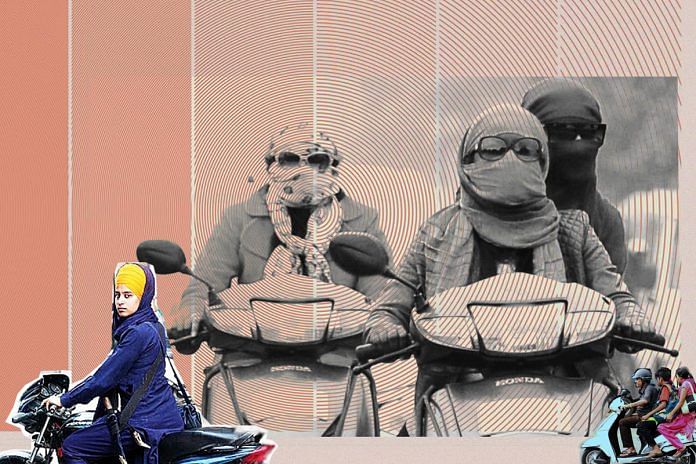Chandigarh administration has decided to revoke the decades-old helmet exemption given to women two-wheeler riders. Sikh bodies are protesting the move and have said that wearing a helmet is against their traditions. Can road safety be compromised for the sake of religion?
ThePrint asks: Helmets compulsory for Sikh women: Ensuring road safety or offending religious beliefs?
Life and death in hands of Vaaheguru, helmet can’t save a person
 Bibi Jagir Kaur
Bibi Jagir Kaur
Former president, Shiromani Gurudwara Prabandhak Committee
Indian courts have already made it clear that a Sikh person cannot be forced to replace or remove his/her headgear. This includes both men and women. The Chandigarh administration cannot differentiate between Sikh men and women and make a rule that says that while Sikh men are exempted from wearing helmets, women are not.
We follow a rehat maryada or rehat nama, a code of conduct that is sacred for us. History is replete with instances where Sikhs have sacrificed their lives to uphold the rehat maryada. Our rehat nama is very clear: Sikhs will not don a topi and that includes a ‘loh topi’ or helmet. During World War I, Sikh soldiers refused to replace their pagris with helmets. We oppose the Chandigarh administration imposing this rule on us which interferes with the tenets of our religion and our traditions. No Sikh body was consulted when the decision to revoke the exemption was taken.
I believe that life and death are in the hands of Vaaheguru (God). If death has to come, a helmet cannot save a person. It is His hukum. If the traffic police want to save lives, they should make driving of two-wheelers safer. Also, instead of imposing this rule on Sikh women, the police should be able to differentiate between a Sikh and a non-Sikh woman. Women with ‘Kaur’ in their name should be exempted while others should wear helmets.
If the rule says women should wear helmets, we’ll have to enforce it
 Shashank Anand
Shashank Anand
IG, Traffic, Chandigarh
In the past five and a half years, as many as 43 women two-wheeler drivers have died in Chandigarh in accidents involving head injuries. Another 191 have been seriously injured. Close to 230-240 families in the city have affected as a result of this. We are a law enforcement agency and we are bound to enforce the law of the land. If the rule says that women two-wheeler riders will have to wear helmets, we will have to enforce it.
I believe it is a welcome decision and a move in the right direction. Good health and wellbeing is one of the sustainable development goals laid down by the UNDP. Goal 3.6 lays down a target that by 2020, we should halve the number of global deaths and injuries from road traffic accidents. Chandigarh is a city where this target can be achieved. In 2010, 140 people died in accidents. By 2017 this number came down to 107, and by the end of 2018 we intend to ensure that it is less than 100. By 2020, the fatalities should not be more than 70-75. Women wearing helmets will contribute to not just to this goal, but should become an essential safety habit.
Women students, young entrepreneurs, office goers use two-wheelers to commute in Chandigarh and it is symbolic of their freedom and independence. They should accept this move wholeheartedly and respect their own lives. Right now we are generating awareness among women commuters and encouraging them to start using helmets. We are running advertisements in theatres and holding awareness camps outside colleges. By the end of this month, we will start the challan process.
Also read: Instead of blaming Sunny Leone, Sikh leaders must address Honey Singh’s sexist songs first
Sikh women should have right to choose whether they want to wear a helmet
 Harjinder Kaur
Harjinder Kaur
Chairperson, Chandigarh Commission for Protection of Child Rights, and former mayor
Right to freedom of religion is a fundamental right enshrined in the Constitution. As a Sikh woman, I am opposed to wearing a helmet. In 1998, when wearing helmets was made compulsory in Chandigarh, I led the agitation which ensured that Sikh men and women are exempted from it. When Sikh men went to war as part of the British army, they were exempted from wearing anything on their heads apart from their pagris. The tenth Guru of the Sikhs Shri Guru Gobind Singhji created the Khalsa as the protector and saviour of others. The turban on a Sikh’s head is a symbol of self-respect which grants him a unique identity as a leader of men. The turban on the head also ensures personal safety.
I am not opposed to women’s safety on roads. I am opposed to a government rule being forced upon a person of a particular religion which interferes with his or her freedom to practice that religion. A Sikh woman should have the right to choose. If she wants to wear a helmet, it is her choice. But if she is protesting against the move, like we are doing, as a Sikh, she should not object to wearing a kesgi if it comes to that. But that issue will come if and when we lose this battle. Right now we are fighting it, tooth and nail.
There are a hundred other traffic hazards which the city has which are dangerous for men and women alike. The administration should work towards solving those as well.
Wearing helmets a basic civic responsibility, can’t be superseded by outdated norms
 Harnidh Kaur
Harnidh Kaur
Poet, Feminist
I’m incredibly glad that Chandigarh has made wearing helmets compulsory for Sikh women. Religion is fine and good, but wearing helmets is a basic civic responsibility and cannot be superseded by outdated mores and values.
Sikh men wearing turbans are afforded a (however meagre) measure of safety, but women are left to their own devises. As women find their autonomy and leave houses to work and study, it’s especially important to enforce ideas of safety.
Sikh bodies never actually pause to ask women what they want or what would make them feel safer. For them, it’s just about being contrarian and staying in political limelight, even if it is by being a nuisance.
I hope the government goes forward with its helmet drive and introduces subsidised helmets for Sikh women buying them for the first time.
The safety of women of my community matters much, much more to me than any kind of religious tantrum. And, I hope the Akali Dal and their ilk keep this in mind when they try to resist a positive step just to stay relevant even as the world realises their hollow, performative religiosity.
Also read: Mamata traffic row gets Bengaluru police thinking of way out of gridlock mess
Sikh bodies putting women’s lives at risk by protesting against wearing helmets
 Chitleen K Sethi
Chitleen K Sethi
Associate Editor, The Print
Anyone driving a two-wheeler, which can go beyond the speed of 30 kmph should wear a helmet. Period. No one should meddle with this basic rule of road safety. Least of all, religion.
Almost everyone who has driven two-wheelers on city roads, especially on wide roads, will have a story on how a helmet saved his/her life. Two decades ago, some Sikh bodies had protested a similar move.
For Sikhs, a headgear is either pagri or dastaar and it cannot be replaced with a metal head cover. As a result, turban-wearing Sikh men were exempted under the helmet drive at that time. But Sikh men who did not wear turbans had to wear helmets.
Since it was not possible for a traffic cop to differentiate between a Sikh and a non-Sikh woman, all women were exempted from wearing helmets. Sikh bodies thought it was a major victory for the community. But in reality, they put every woman, who drove a two-wheeler in Chandigarh, at risk.
Some may even argue that those protesting against Sikh women wearing helmets be booked for culpable homicide when a woman dies in a road accident just because she was not wearing a helmet.
Although I know many women wear helmets out of choice, revoking the exemption is the right decision. Chandigarh police has managed to record over 90 per cent compliance in helmet-wearing among men. And, it is likely to ensure the same in the case of women now.
Sikh women who think wearing a helmet interferes with their religion, the Chandigarh administration has given them a choice: wear a kesgi or a dastaar to cover your head and no one will challan you.
Compiled by Chitleen K Sethi, associate editor, The Print



